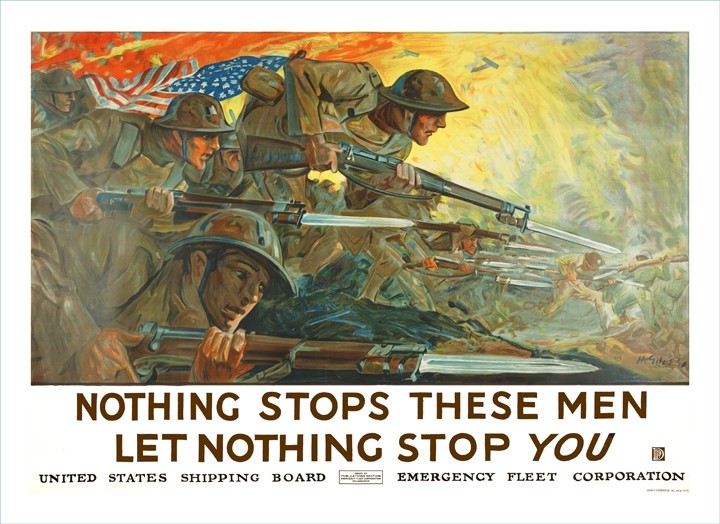Less than two weeks after America entered World War I, the Society of Illustrators held a meeting in New York City to examine the ways in which artists might rally to their countryAca,!a,,cs cause. Charles Dana Gibson, AmericaAca,!a,,cs highest-paid artist and President of the Society, received a telegram from former journalist George Creel, currently the Chairman of the United States Committee on Public Information, with a request from President Woodrow Wilson. That request would ask Gibson to appoint a committee of artists to help in producing artwork for the Great War effort. On April 17, 1917, at a dinner at the Hotel Majestic in New York City, the first gathering of artists after the declaration of war took place. Gibson recalled that Aca,!A"We were just finishing dinner when the telegram arrived asking us to participate as artists to produce artwork for our countryAca,!a,,cs cause. Art work that would bolster morale, and compel citizens to enlist for combat, buy war bonds, conserve resources, and to accept sacrifices and losses for their country. That telegram from the President gave us our focus point; we would make art that would inspire a nation.Aca,!A?
On April 22, 1917, Gibson met with Creel in New York City and the Division of Pictorial Publicity of the Committee on Public Information was formally launched, just nine days after Creel himself had received his mandate from President Wilson. Creel later described his feelings: Aca,!A"Even in the rush of the first daysAca,!A|I had the conviction that the poster must play a great part in the fight for public opinionAca,!A?. The printed word might not be read; people might not chose to attend meetings or to watch motion pictures, but the poster billboard was something that caught even the most indifferent eye. What was needed, what we absolutely had to have, were posters that represented the best work of the best creative artists of our time. Looking the field over, it was decided that Charles Dana Gibson was the best man to lead the army of artists.
The muster roll of the Division of Pictorial Publicity contained the names of 279 artists and 33 cartoonists. Among them were such well known painters as George Bellows, Kenyon Cox, Arthur G. Dove, William Glackens, F. Luis Mora, Joseph Pennell, Frank E. Schhoonover, Albert Sterner, H. Giles, and N.C. Wyeth. The roster also included very famous illustrators such as Howard Chandler Christy, Harrison Fisher, Joseph Leyendecker, Edward Penfield, Jessie Wilcox Smith and James Montgomery Flagg to name but a few. In addition there were those whose work for the Division made them famous: Charles Livingston Bull, Dean Cornwell, Harvey Dunn, Gordon Grant, Herbert Paus, and Ellsworth Young.
Gibson described the divisionAca,!a,,cs operations in a New York Times article: Aca,!A"We have a meeting every Friday night where we meet men who are sent to us by different departments in Washington with their requests for posters, ideas are exchanged and the best artist for the job is selected.Aca,!A? Gibson constantly encouraged his artists to create posters to represent ideas, not events. Aca,!A"We must see more of the spiritual side of the conflict and we must illustrate the great aims of this country in fighting this war.Aca,!A? Gibson also stated that Aca,!A"there wasnAca,!a,,ct an artist in the whole division, man or women who didnAca,!a,,ct offer the best that was in him.Aca,!A? In its twenty months of existence between April, 1917, and November, 1918, the Division of Pictorial Publicity produced seven hundred poster designs for fifty-eight separate government departments and patriotic committees.
What do we need to do today Aca,!A"to support our Troops and to inspire our Nation'Aca,!A?














Social Sharing